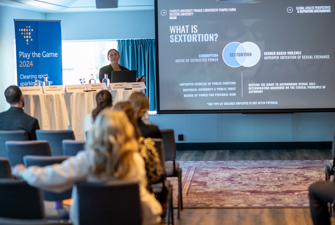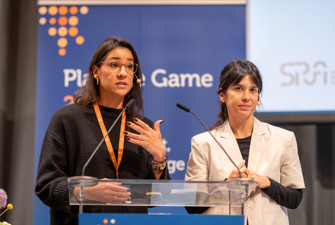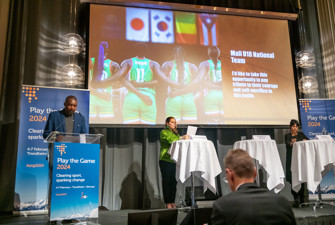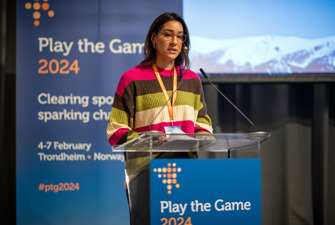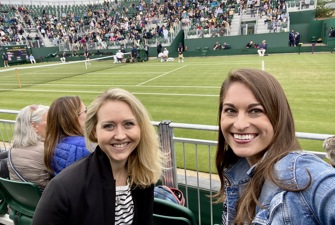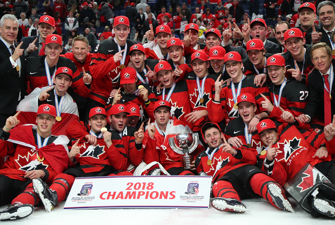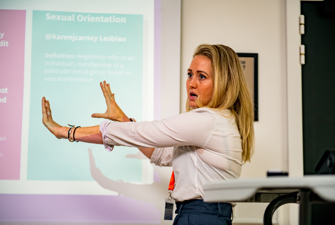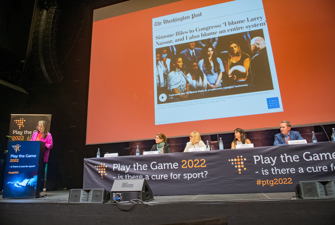The definition of child labour in sport is still developing
A new white paper on child labour in sport from the Centre for Sport & Human Rights outlines 17 recommendations to protect child athletes. Lars Jørgensen unpacks how child labour in sport is still not clearly defined and how that impacts on the welfare of child athletes.
The 15-year-old Russian figure skater Kamila Valieva’s doping case at the Olympic Winter Games in Beijing in February 2022 sparked new life into an old discussion about child labour in elite sport. Following public discussions of the case, the International Skating Union (ISU) recently accepted to raise the age limit for figure skating competitions as well as competitions in speed skating, short track speed skating, and synchronised skating from 15 to 16 next year and 17 in 2025.
But according to a new white paper on child labour in sport from the Centre for Sport & Human Rights, much more is needed to protect the rights of child athletes than raising the age limits in elite sport.
The whitepaper concludes that since athletes are the key players in the global industry of high-performance and professional sports, and since playing careers tend to be quite short, the industry depends on a constant pipeline that delivers aspiring and talented child athletes.
However, the paper says, the child athletes’ work, which involves early specialisation in a sport, intensive and high-volume regular training and involvement in repeated high stakes competition, meets the criteria for child labour outlined in both ILO and UN conventions.
Furthermore, the paper argues that there is a risk of child athlete abuse because children’s development as athletes is facilitated by a wide range of adults, some of whose livelihoods depend on the work of the children.
Based on evidence derived from an in-depth review of relevant literature, and from a series of 24 consultations with various expert groups, the white paper outlines 17 recommendations on how to protect child athletes.
The recommendations include “advocating the recognition that some aspects of children’s participation in sport are analogous to child labour; asserting that children’s rights guide all decisions concerning children in situations analogous to child labour; and arguing that sports bodies and states should introduce and regulate appropriate minimum ages, and maximum hours for children’s training and competition in elite sport.”
Huge data gap on number of athletes engaged in child labour
The UN agency International Labour Organisation (ILO) has been supportive in the development of the new white paper, and Benjamin Smith, a senior child labour specialist at the ILO, welcomes it.
“It’s very worthwhile to explore the linkages between child labour and sports. The ILO has addressed this issue directly in the past in relation to the use of children in sport like trafficking of camel jockeys and horse jockeys. These things are common to the ILO supervisory mechanisms, and we are certainly concerned about that,” Benjamin Smith says.
Asked about the global scale of child labour in sport, Benjamin Smith points to the fact that 160 million children in the world are involved in child labour. 70 percent of them are working in agriculture, the rest are employed in the industry and the service sector.
“So, in terms of the overall picture, child labour in sport is not a big part of the child labour problem by any means. We have seen it in specific instances where complaints were brought to the ILO about the use of children,” Benjamin Smith explains.
In terms of the numbers of children who are in what the white paper describes as “situations analogue to child labour”, the ILO senior child labour specialist argues that more data are needed:
“There is a huge data gap in that area. It is an area there has not been a lot of research on, and the ILO has not really gotten into unpacking these linkages to any great extent. But the definition of child labour is very clear in our conventions. It involves things like long hours, exposure to hazards, and risk of injury and decease.”
The definition of child labour in sport is still developing
Benjamin Smith recognises that the paper has helpfully unpacked and analysed the definitions of child labour in relation to child athletes:
“It’s a useful paper but there are grey areas. Sport is tremendously beneficial to children in most cases, but of course it can also be quite the opposite and become very harmful to children which the white paper explains. What is child labour in sport and what is not child labour in sport is still kind of developing concepts that the white paper has helped to explore.”
According to Benjamin Smith, the ILO will look further into the concept of child labour in sport in the future. He sees the Global Dialogue Forum on Decent Work in the World of Sport, which was held in Geneva in January 2020, as the first step in that direction.
“The Global Dialogue Forum established some important principles and stated that all athletes have fundamental labour rights. These include freedom from child labour and forced labour, non-discrimination, and freedom of association. That right to be free from child labour applies to all children whether they are paid or not paid and whether they are working in the family or outside of the family,” he says while adding that there is a follow-up process.
“The ILO is a founding member of the Centre for Sport & Human Rights, and our collaboration is ongoing. We participated in a side event at the recent 5th Global Conference on the Elimination of Child Labour, where the white paper on child labour in sport was presented. Our work with the Centre for Sports & Human Rights as well as the IOC and other sports federations and governing bodies will continue. There is a protection gap there that we feel we can help fill.”
Trafficking of children in some sports is a major problem
Andrea Florence, Acting Director of the Sport and Rights Alliance and a member of the expert steering committee that supported the strategy, methodology, and drafting of the white paper on child labour in sport, says there has been a widespread reluctance to consider children’s participation in sport as work given the importance also of identifying and ending child labour worldwide.
“Not all work by children automatically qualifies as child labour that should be eliminated. This accountability and legislative gap mean that many actors gain from the work of child athletes, including through the monetisation of children’s personal data. It also means that children are often left outside of player union representation and protection outreach, and that specific education programmes on child athletes’ rights are not developed.”
Last year, World Players Association's 2021 CARE Report, the first global study of athletes’ experiences in sport when they were children, found that 51 percent of elite athletes had experienced economic exploitation when they were under the age of 18.
To Andrea Florence, this report documents that children’s engagement in intensive, excessive hours training and high stakes sport competitions for someone else’s gain needs regulation. And she argues that the new white paper on child labour in sport demonstrates how the so-called ‘autonomous nature’ of sports organisations has helped to exempt sports federations from labour regulations.
“Sale and trafficking of children is recognised as one of the worst forms of child labour. The paper found that it occurs in certain sports, most notably in football, baseball, basketball, and ice hockey, and often involves children being moved from the Global South to the Global North,” Andrea Florence says while also noting that regulations do not necessarily protect child athletes:
“FIFA has regulations for the international transfer of minors, but these have proven difficult to monitor or enforce. Parents are deceived by false promises and fraudulent contracts into sending their children outside of their home country.”
Furthermore, Andrea Florence says, children are usually unaware of their rights when engaged in sport. 69 percent of the elite athletes that took part in World Players Association’s 2021 CARE Report said they were not aware of their rights when they were children:
“If children are not aware of their rights, they are also often unsure how to report and to whom. Child friendly reporting mechanisms are urgently needed. They should be introduced in consultation with athlete representative bodies, easily accessible, widely communicated, independent, trustworthy and grant access to mental, legal, and physical support.”
A clear understanding of child labour is important to protect athletes
To Syliva Schenk, Chair of the Working Group on Sport at Transparency International Germany, only with a clear understanding of what constitutes child labour in the sport context, sport organisations as well as parents, governments, and policy makers will be able to establish structures and policies that prevent exploitative situations and ensure children’s rights.
“Wherever children are training and competing in high level sport not for their own sake but for the sake of their parents, coaches, clubs etc., we see a ‘red flag’ signalling the risk of misuse of power. Children can be a victim of exploitation in sport, often accepted or even supported by their own parents who want success, financial gain and/or publicity,” she says.
“Boundaries between sport being a hobby and sport being work are often vague but that cannot be an excuse. On the contrary, that makes it even more urgent to clearly define the responsibility of sports organisations, parents, governments, and the public alike.”
According to Sylvia Schenk, the dependency of especially young athletes on their coach can even lead to sextortion, abuse of power for sexual benefit, which Transparency International in 2020 focused on in the report Breaking the Silence Around Sextortion.
“While parents are expecting their child to ‘pay back’ with sporting success on any investment in its career in early years, the child is under pressure to please its parents and not upset the coach. In a constellation like that, young athletes are facing double exploitation as a child working to contribute to the family’s income and as a victim of sexual abuse.”
Child labour in sport often leads to sexual abuse
In 2020 prior to the Olympic Games in Tokyo, the Human Rights Watch report I was hit so many times I can't count, which included experiences of more than 800 former child athletes in 50 sports, documented physical, sexual, and verbal abuse of child athletes in Japan that resulted in depression, suicides, physical disabilities, and lifelong trauma.
The Japan report and several other Human Rights Watch investigations of abuse in sport in countries such as the US, Afghanistan, Haiti, and Mali, leads Minky Worden, Director of Global Initiatives at Human Rights Watch, to conclude:
“The common threat is horrific governance. All sports have statutes saying they have zero tolerance against abuse. Yet, in Human Rights Watch’s research we have found that verbal, emotional, physical, and sexual abuse is rampant. Whenever we and investigative journalists dig into these cases, it is much worse than you can ever imagine,” she says.
“And the whistle blowers, often teenagers, are savaged by the system they look to for protection. Whether it was in the US, Japan, Haiti, or Mali, everybody knew about the abuse and did nothing for years and decades.”
Minky Worden blames the IOC for refusing to recognise sport as labour because to her there is a clear connection between child labour in sport and other violations of athletes’ rights.
“Child labour in sport creates the conditions often for what we later see as sexual abuse,” she says while also mentioning child doping as a classic abuse in sport that goes back to the Cold War.
“All of these rights are interconnected. The right to access to sport, the right to education, the right to health. But child labour occurs in sport and the lack of pay contributes to the conditions where young athletes could be groomed for physical, verbal, emotional, and sexual abuse. So, all these rights are also related to poor governance in sport and a total lack of safeguarding.”
To the question why sport federations and governments have not done more to protect children from being abused in sport, the Human Rights Watch director says:
“Because they haven’t had to. Sport federations and governments are already obliged to protect child athletes, but they don’t. Everything seems to be allowed if you are competing to win medals for your country. You can beat children in sports training for the glory of the nation. But it was wrong in Nazi Germany, and it is wrong now.”
When asked if she sees any differences between child labour in sport and child labour in general, Minky Worden answers:
“Yes, the acceptance of governments of this in sport.”
A good example of child protection in Norway
But according to the Centre for Sport & Human Rights’ white paper on child labour in sport there are also a few national role models, and the white paper names Norway as one of them. Norges Idrettsforbund (NIF), the national sport federation in one of the world’s leading winter sport nations, have two regulations in place to protect child athletes.
“The Provisions on Children’s Sport were adopted already in 1987 and concerns competitions,” Mads Andreassen, Head of Activity Development at NIF, explains.
“These are regulations stating how far you can travel to compete at which age. How prizes should be given to all participants, and when you can start using lists of results or tables. The provisions can be sanctioned and are absolute rules.”
In 2007, NIF also adopted Children’s Rights in Sport that are based on the UN convention on the rights of children.
“These rights describe the different factors that should be taken into consideration organising activities for children. The children’s rights work as guidance to make sure we have a child-centred approach to their activity. Children’s sport is not a tool for future elite sport but serves as a value here and now for the children that are involved,” Mads Andreassen says.
He adds that the Norwegian provisions and rights are unique in a global context and should contribute to children having a positive experience every time they are in training or competitions.
“In sports, children should make friends, feel safe, want to try new things, and not be afraid to make mistakes. Children are children, not small adults. The sports activity and competitions must therefore be developed and adapted for children, so that they are encouraged to learn new things and are motivated to continue with sports so long as possible.”
The Norwegian regulations on children’s sport are in place to secure that the competitions and activities follow the children’s natural development and age. Competitions must be open to everyone, take place as close to home as possible and avoid early focus on results. Rankings and publication of result lists are gradually introduced.
“We believe that this way of organising sport contribute to higher participation in children and youth sport. As many children as possible continue in sport for as long as possible. In 2001, 71 percent of all children in Norway had been a member of a sports club. In 2010, the number was 85 percent, and in 2017 it had risen to 93 percent,” Mads Andreassen says while noting:
“The consequence of a child-centred child and youth sport, where the target is to keep as many as possible so long as possible, is high quality elite sport. Norway also scores very high on rankings such as www.greatestsportingnation.com.”
Read more
Read the white paper from Centre for Sport & Human Rights: ‘Child Labour in Sport. Protecting the Rights of Child Athletes’
